OCOC ORIGINAL
Diplomatically Navigating the GeoPolitical Waters
Our Country Our Choice Article of the Week
by Greg Taylor with Mary Otto-Chang, HBA, MES, PhD (Candidate)
Realignment of US - PANAMA RELATIONS
SPECIAL DOUBLE FEATURE
PANAMA PART TWO
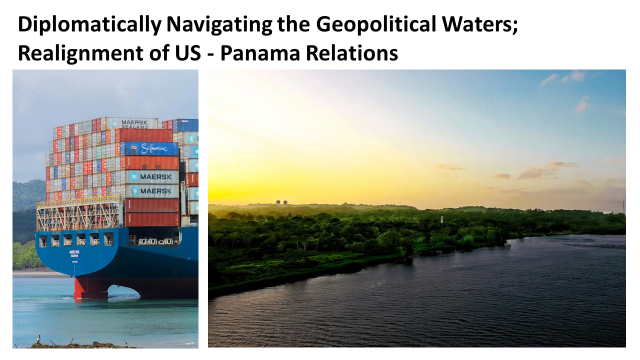

In recent weeks, significant developments have occurred regarding the Panama Canal. Since our previous newsletter, there has been a substantial influx of information on this critical issue
The Panama Canal holds considerable strategic importance for United States national security, and the United States is committed to ensuring its neutrality.

In our earlier analysis, titled “The Panama Paradox,” we examined several key issues, including the increasing influence of China and the perceived shortcomings of U.S. foreign policy in safeguarding American interests in Panama. We explored how China managed to establish a presence in Panama and undertake significant infrastructure projects without sufficient scrutiny from the U.S. State Department, raising concerns about the geopolitical implications.
This follow-up article delves deeper into China’s activities in Panama and the necessary adjustments in U.S. foreign policy to address the evolving situation in the Isthmus.
President Trump’s US Foreign Policy
The United States has swiftly acted after the transition to the Trump Administration to refocus its foreign policy on US national interests, shifting from the more globalist orientations of the Obama and Biden administrations. It is now imperative to consider measures that will contribute to America’s resurgence.
 This contrasts with the past approach where the US, as the unipolar power since the Cold War, focused predominantly on tactics. Secretary Rubio stated, “It has to start with strategy. What is the strategic objective? What is the purpose of the mission? And I think the mission of American foreign policy, and this may sound sort of obvious, but I think it’s been lost; the interest of American foreign policy is to further the national interest of the United States of America.”
This contrasts with the past approach where the US, as the unipolar power since the Cold War, focused predominantly on tactics. Secretary Rubio stated, “It has to start with strategy. What is the strategic objective? What is the purpose of the mission? And I think the mission of American foreign policy, and this may sound sort of obvious, but I think it’s been lost; the interest of American foreign policy is to further the national interest of the United States of America.”
This new direction in foreign policy markedly differs from the previous internationalist stance, which saw limited response from the US State Department as China extended its influence around the Panama Canal.
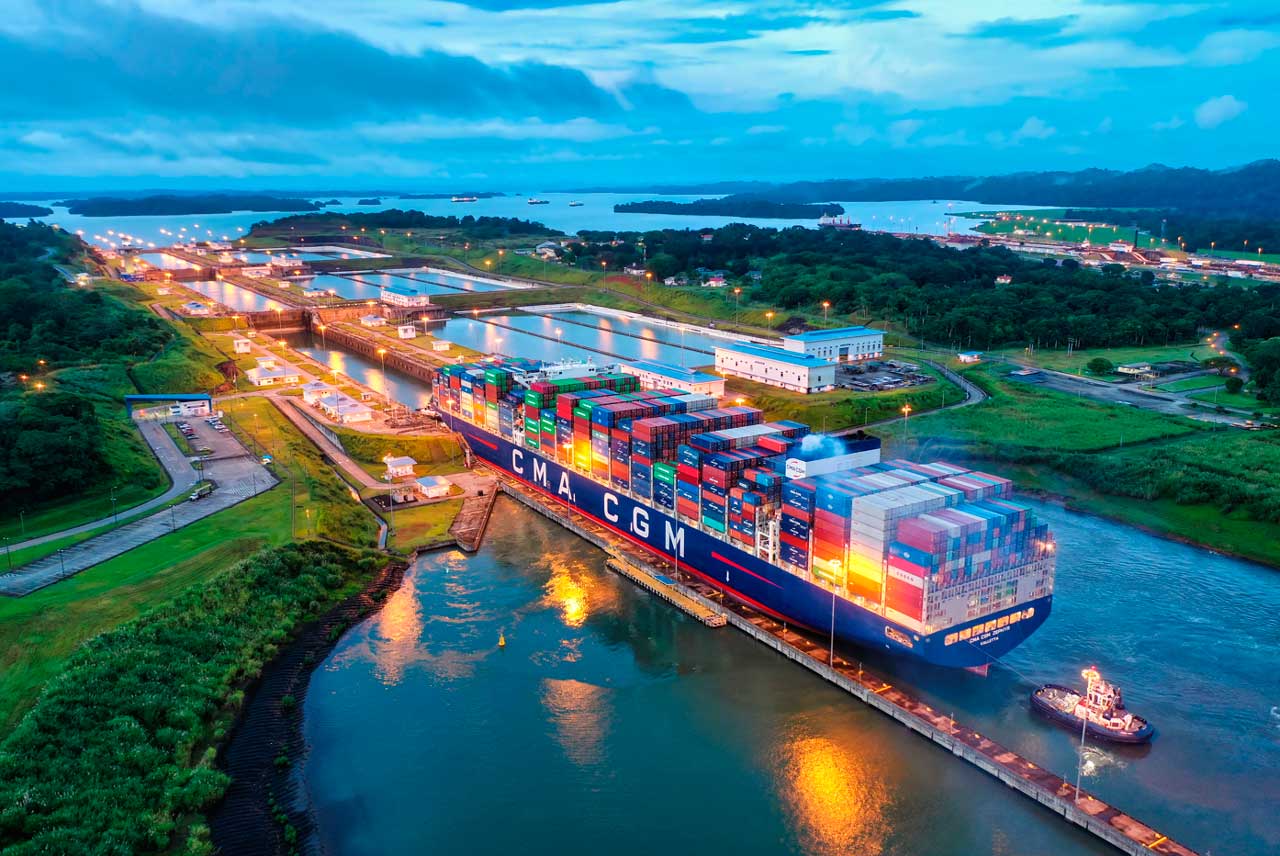
While the matter remains unresolved at the time of writing this follow-up newsletter, it is evident that the US is reclaiming its position and exerting greater control.
The U.S. Senate’s Debate on the Panama Canal
 Senator Cruz cited evidence suggesting Panama might be in breach of the canal’s neutrality treaty, specifically regarding Chinese operations at the canal’s ports by Hutchinson Port Holdings (HPH) and the construction of the fourth bridge by the China Communications Construction Company (CCCC), a company with a history of corruption and illegal activities worldwide.
Senator Cruz cited evidence suggesting Panama might be in breach of the canal’s neutrality treaty, specifically regarding Chinese operations at the canal’s ports by Hutchinson Port Holdings (HPH) and the construction of the fourth bridge by the China Communications Construction Company (CCCC), a company with a history of corruption and illegal activities worldwide.
Senator Cruz stated, “The danger is China exploiting or blocking passage through the canal,” and added, “Chinese companies are currently constructing a bridge across the canal at a slow pace, which may take nearly a decade to complete. The partially completed bridge could allow China to block the canal without warning. Additionally, Chinese companies control container ports at both ends, providing observation posts for timing such actions. This situation poses risks to our national security.”
Senator Sullivan was equally as alarmed at the current situation focusing on corruption endemic is Chinese operations; “CCP officials are known to bribe officials in other countries. They do it all the time. No offense to Panama, but they don’t have the greatest reputation of having officials who are on the take.”
Although the near complete globalist corrupt Biden administration lead the world in “bought off politicians”, American politicians have loved to pretend that all is well, although it seems as though almost all was rotten, judging by the amount of clean up President Trump and his team are undertaking.
Sullivan correctly added to that with a stark reminder of whose interests the Chinese firms put first; “Let’s assume China invaded Taiwan or the Philippines or went to war somewhere in the South China Sea, and we were surging our Navy to the Pacific through the Panama Canal, are the companies controlling both sides of the Panama Canal subject to the Chinese national security laws that mandate cooperation with the military and state intelligence agencies?…Isn’t that a huge risk to us right now, that they could go to these companies and say, ‘Hey, shut it down. Sink a ship in the canal.’ Wouldn’t they be obligated to do that under Chinese law?”
Senator Sullivan elaborated on the espionage threat, stating, “It is reasonable to consider that companies such as Balboa and Cristobal may have individuals among their employees who are associated with Chinese intelligence or military. This consideration is likely accurate.”

Although this article does not explicitly mandate active espionage, it implies an obligation to assist in intelligence activities if legally directed by authorities. Additionally, there is the National Security Law of the People’s Republic of China (2015). This law broadly defines national security and could be used to justify actions deemed necessary for national defense or security. It includes provisions for protecting national interests, which could theoretically encompass strategic actions during times of conflict or as part of geopolitical strategies.
Another perspective is that, although these laws provide a legal basis for asserting influence or seeking cooperation, their implementation in international waters or on foreign territory where HPH operates could encounter legal, diplomatic, and operational challenges. These laws are primarily applicable within Chinese jurisdiction, and their enforcement or relevance outside China would largely depend on international law, local regulations, and the details of HPH’s concessions and operations agreements in Panama. It might require a significant geopolitical motivation for China to undertake such actions.
The discussions illuminated the geopolitical importance of the Panama Canal to the US and the potential risks associated with China’s involvement. The debates raised questions about whether the Senators were justified in their scrutiny of HPH and those responsible for constructing the new bridge over the canal.
Management of the Ports and the Diplomatic Switch to China
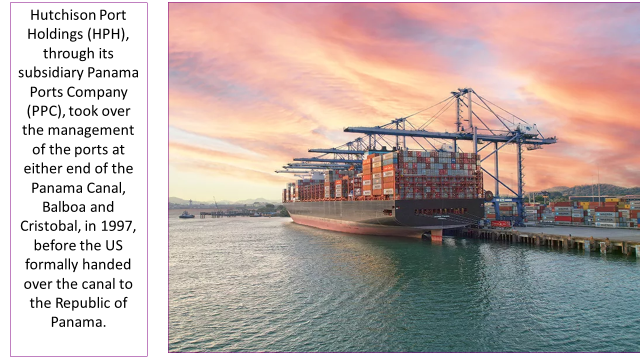
HPH is based in Hong Kong a Special Administrative Region of China under the “One Country, Two Systems” principle. In 1997 that would have provided HPH with autonomy but as the years have moved on so has China’s control of Hong Kong, particularly following changes in Hong Kong’s legal and political landscape, like the National Security Law introduced in 2020. This law gives Beijing more direct influence over entities in Hong Kong, potentially impacting corporate decisions if they are deemed to relate to national security or strategic interests.
HPH’s presence in Panama was fortified following Panama’s diplomatic shift from Taiwan to China in 2017. There was a historical push for this switch; President Juan Carlos Varela had reportedly expressed interest in establishing ties with China a decade before the switch actually occurred. With China as the second largest trading nation to use the canal after the United States, Varela decided to make the switch to China.
At the time, Varela’s decision was met with criticism regarding the transparency of negotiations and the potential for corruption. Reports in Panamanian newspapers like La Estrella de Panamá hinted at undisclosed financial incentives or arrangements that might have influenced this diplomatic shift, casting a shadow over the integrity of the process.
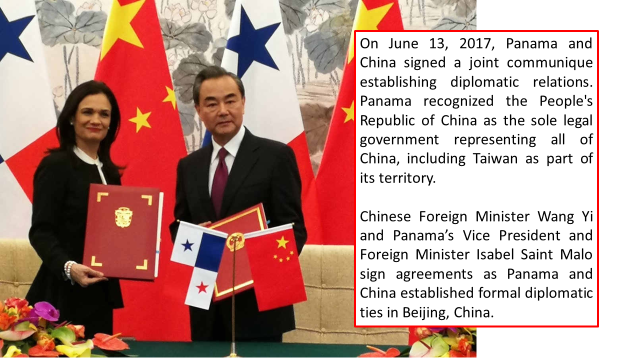
Over the first year of diplomatic relations, 19 treaties or agreements were signed. These included agreements aimed at facilitating trade and encouraging Chinese investment in Panama, particularly in infrastructure projects and Panama became part of China’s Belt and Road Initiative, which could lead to further investments in infrastructure.
Although specific projects weren’t detailed in immediate announcements, the understanding was that Chinese companies would have easier access to invest in or develop Panamanian infrastructure, including potentially around the Panama Canal with undoubted understandings related to maritime cooperation, enhancing the canal’s capabilities, or expanding port facilities managed by Hutchison Port Holdings.
By 2017 the die was cast, and China was on the road to controlling the strategic chokepoint for international trade: The Panama Canal.
There was little pushback from the US State Department.
The Fourth Bridge over the Panama Canal
Chinese influence over the canal is not purely limited to the ports at either end. The Panama Canal has long been serviced by three bridges, but the need for additional infrastructure to manage growing traffic became evident. Thus, the idea of the Fourth Bridge over the Panama Canal was conceived, aimed at connecting Panama City with the province of Panama Oeste to alleviate congestion and improve connectivity.
The Consortium
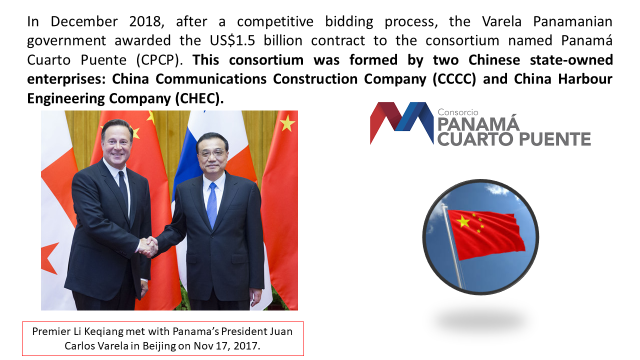 CCCC is a Chinese majority state-owned enterprise. It operates under the guidance of the Chinese government and has been explicitly noted for its involvement in initiatives that align with CCP policies, including the Belt and Road Initiative. CCCC has been accused by U.S. officials of advancing CCP military expansion and other geopolitical strategies, particularly in the South China Sea with the construction of military outposts. CCCC’s close ties with the CCP are also evident from its participation in state-level engineering projects in China and its involvement in international projects that serve Chinese strategic interests.
CCCC is a Chinese majority state-owned enterprise. It operates under the guidance of the Chinese government and has been explicitly noted for its involvement in initiatives that align with CCP policies, including the Belt and Road Initiative. CCCC has been accused by U.S. officials of advancing CCP military expansion and other geopolitical strategies, particularly in the South China Sea with the construction of military outposts. CCCC’s close ties with the CCP are also evident from its participation in state-level engineering projects in China and its involvement in international projects that serve Chinese strategic interests.
As a subsidiary of CCCC, CHEC shares the same state-owned enterprise status and thus has inherent ties to the CCP. Its activities, including construction projects worldwide, are aligned with China’s geopolitical strategies, including those under the Belt and Road Initiative. CHEC has been involved in significant infrastructure projects in various countries, often in accordance with China’s state-led development strategies, which are directly influenced by the CCP.
Timescale
Initial work on the project was set to begin shortly after the contract was awarded, but significant delays ensued. The change in Panamanian government leadership after the 2019 elections, from Varela to President Cortizo led to a reevaluation of infrastructure projects, including this bridge. To those with local knowledge, such delays are not unexpected as financial incentives are realigned.
An addendum to the original contract in March 2023 adjusted the design, removing some features like a viewpoint and restaurant, which necessitated further design work before physical construction could commence. Construction was officially planned to restart in the “coming months” following a June 2023 agreement, with detailed design work and field studies continuing thereafter.
Given the scale, the project would likely employ both local Panamanian workers and international labor, with a significant portion potentially from China, given the consortium’s background and prior history of the consortium members. Undoubtedly, the Chinese will be unlikely to pass up an opportunity to install spies into the consortium labor force.
The bridge, which was initially expected to be completed by around 2021 if construction had started without delays, now has an uncertain completion date due to the stoppages and redesigns. Optimistically, completion might be anticipated around 2028, assuming no further significant delays.
Corruption and Illegality
Both CCCC and CHEC have histories marred by allegations of corruption. CCCC was notably banned by the World Bank for six years (from 2011 to 2017) for fraudulent practices in the Philippines, where they were found to have engaged in bid rigging for road projects. This ban included all affiliates and subsidiaries, highlighting systemic issues within these companies.
The ban was a result of CCCC’s involvement in corrupt practices, specifically bid rigging, highlighting a broader pattern of unethical behavior in international projects.
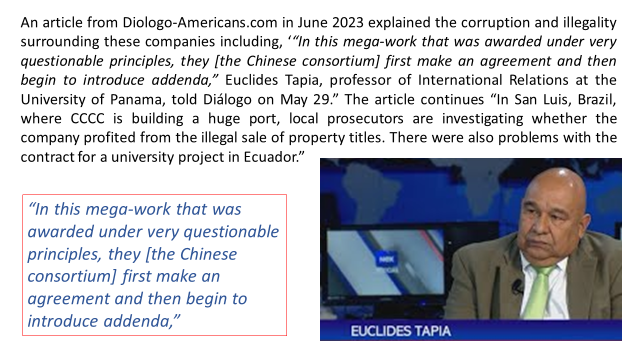
With red flags aplenty going off with the involvement of a corrupt CCP controlled consortium working over the geopolitically imperative waterway, the U.S. Ambassador to Panama, Mari Carmen Aponte, did express concerns. While there isn’t a direct quote from her specifically on this bridge project, it’s noted that she had previously cautioned against the situation escalating to a point where Panama would have to choose between the U.S. and China. This caution was in relation to broader U.S.-China competition in Panama, including infrastructure projects like the bridge. It seems that the past Administration’s State Department was more concerned with international consensus that the protection of and the neutrality of the Panama Canal.
Despite the former State Department’s laissez faire approach with CCCC’s direct link to the CCP, some will see the work on the fourth Panama Canal bridge as an active threat to the function of the canal.
Other Chinese Operations in Panama
The ports at either end of the canal and the bridge being constructed over it are not the only Chinese operations in Panama. As mentioned in the earlier newsletter, Chinese fingerprints are all over the migrant Camp Delta in the Darien and a six lane bridge to the middle of the jungle that was expected by some to be part of a road that would cut through the Darien and link Panama and Colombia.

The Amador Convention Center, a centerpiece of the Ricardo Martinelli Administration’s construction projects had over 2000 critical and serious flaws in its design, construction, and structure, according to a technical report from Panama’s Tourism Authority of Panama (ATP) in 2019. It is now open.
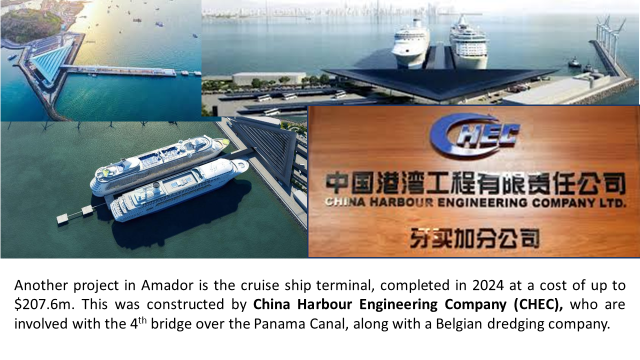

As well as these major projects, there are also a number of Chinese companies based in the Ciudad de Saber, of City of Knowledge, alongside a number of international NGOs that were involved with migration through Panama to the US.
The prevalence of recent construction projects involving firms linked to or directly owned by the Chinese Communist Party is notable and will provide context to the extent that the US’s main geopolitical opponent is dominant in Panama, and around the strategically important Panama Canal.
One often overlooked aspect of Chinese influence is that 17% of people in Panama are of Chinese descent. Many of these individuals are descendants of workers who helped construct the Panama Canal over 100 years ago, while others are recent immigrants who have settled in Panama through “Friendly Nation” visas that grant residency.
It is difficult to overstate the extent of Chinese influence in Panama.
Reaction in Panama to Trump’s Threats
President Trump’s call for Panama to relinquish control of the Panama Canal was met with strong opposition both politically and publicly. Panamanian President José Raúl Mulino was among the first to rebuff these demands, asserting Panama’s sovereignty over the canal.
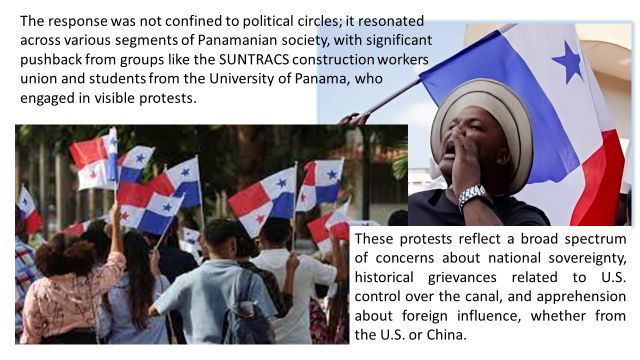 In the media and among politicians, there was a concerted effort to clarify the situation regarding China’s involvement in Panama. While Chinese companies have indeed invested in various infrastructure projects across the country, including near the canal, the consensus was clear: China does not control or influence the operations of the Panama Canal Authority. This point was articulated to affirm Panama’s governance over its most critical asset.
In the media and among politicians, there was a concerted effort to clarify the situation regarding China’s involvement in Panama. While Chinese companies have indeed invested in various infrastructure projects across the country, including near the canal, the consensus was clear: China does not control or influence the operations of the Panama Canal Authority. This point was articulated to affirm Panama’s governance over its most critical asset.
Secretary Rubio’s Visit to Panama
Before U.S. Secretary of State Marco Rubio’s visit to Panama on February 2, 2025, President José Raúl Mulino made it clear that he would not entertain any discussion regarding control of the Panama Canal. In a press conference on January 30, 2025, Mulino asserted, “I cannot negotiate and much less open a process of negotiation on the canal. That is sealed. The canal belongs to Panama.” This statement was in direct response to President Donald Trump’s earlier threats. Mulino emphasized that any talk about canal control was non-negotiable, focusing on Panama’s sovereignty and the legal obligations under the existing treaties.
While specific details of the closed-door meeting between Mulino and Rubio were not publicly disclosed, it’s inferred from various sources, what the agenda included. Rubio was expected to press Mulino on reducing or clarifying China’s economic footprint in Panama, especially concerning the canal and related infrastructure projects like ports operated by Chinese companies. Issues like illegal migration through the Darien Gap and regional security against drug trafficking were likely on the table, with Rubio seeking cooperation in these areas.
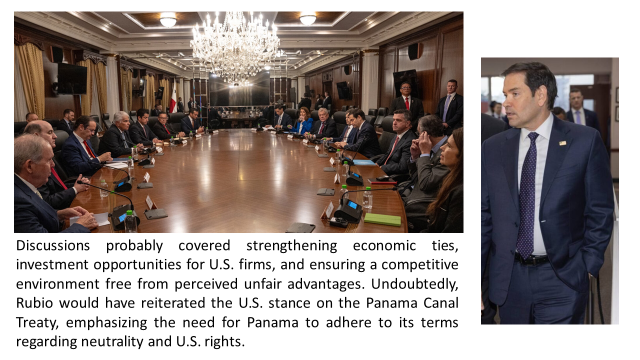
Following the meeting, Mulino’s tone shifted from outright rejection to a more diplomatic and conciliatory stance. Mulino reassured the public that there was no threat to Panama’s sovereignty over the canal, stating, “I don’t feel that there is any real threat at this time against the treaty, its validity, and much less the use of military force to seize the canal.” He mentioned an ongoing audit of Chinese-operated ports and indicated a willingness to review these agreements, signaling an openness to address U.S. concerns without compromising Panamanian control. Mulino highlighted the positive and respectful nature of the discussions, suggesting a strategic pivot towards enhanced U.S. collaboration while not abandoning Panama’s independent stance.
Post Meeting Fall Out
Following the Rubio – Mulino meeting, there were indications of policy adjustments. Mulino announced that Panama would not renew its participation in China’s Belt and Road Initiative, which had been joined under the previous administration. This was seen as a move to reassure the U.S. of Panama’s alignment with American interests.
The meeting sparked debates in Panamanian media, with some viewing Mulino’s approach as a necessary diplomatic maneuver to balance between two superpowers, while others criticized it as capitulation to U.S. demands.
The U.S. State Department issued statements indicating that Rubio had made it clear to Mulino that the status quo regarding Chinese influence was unacceptable, hinting at potential U.S. actions if changes weren’t forthcoming. However, President Trump was reportedly unhappy with Rubio’s handling of the situation, as Rubio did not secure the concessions Trump had demanded, particularly regarding the control of the Panama Canal or the reduction of Chinese influence. Trump’s frustration was evident in his public statements and on social media, where he indicated that Rubio did not do enough to secure U.S. interests.
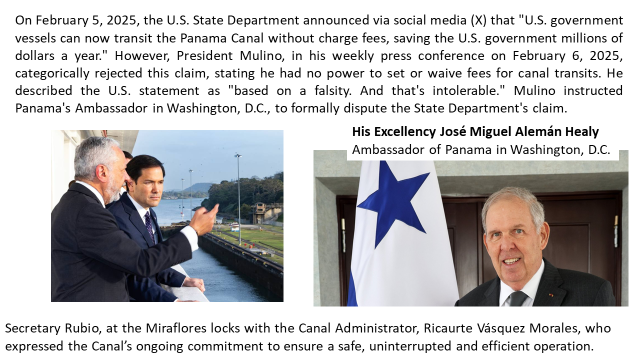
Whatever was or was not agreed the geopolitical issues surrounding the canal seem far more important than what US vessels will be charged. A call between President Trump and President Mulino, scheduled for 7th February 2025 intended to follow up on Sec. Rubio’s meeting has been cancelled because of, according to La Prensa, “a last-minute change to the US Presidential Agenda.”
China’s Reaction
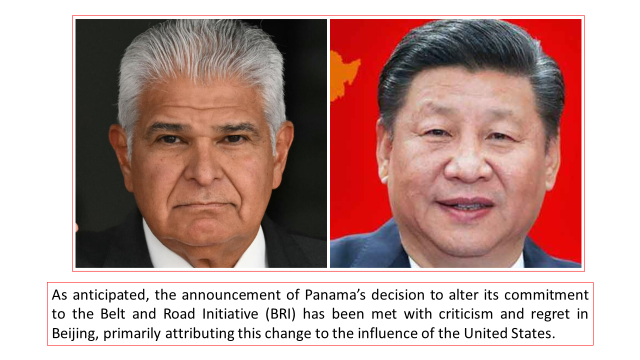
The Chinese Foreign Ministry, represented by spokesperson Lin Jian, expressed strong opposition to what they described as U.S. “pressure and coercion” aimed at undermining BRI cooperation. According to statements reported by various news outlets, including CBS News, China expressed disappointment over Panama’s decision while highlighting that the BRI is an economic cooperation initiative involving over 150 countries globally, with more than 20 participants from Latin America and the Caribbean (LAC). Lin Jian reiterated China’s hope that Panama would consider the broader bilateral relationship and the long-term interests of both nations.
China’s response included allegations that the U.S. was employing pressure tactics to create discord between China and Latin American countries, interfere in China’s internal affairs, and undermine China’s legitimate rights and interests. This reaction underscores the wider geopolitical tensions, particularly the strategic competition between China and the U.S. in Latin America, where infrastructure projects under the BRI are viewed as instruments of influence. China perceives Panama’s withdrawal not merely as the loss of a project but as a setback in its broader regional strategy, compounded by perceived U.S. interference.
And so for now…
Currently, US foreign policy efforts are focused on protecting the Panama Canal as a strategic asset and reasserting the United States’ geopolitical influence in the Isthmus. Panama has agreed not to renew its Belt and Roads Initiative (BRI) accord with China; however, it has yet to address Chinese influence through entities such as Hutchison Ports Holdings (HPH) at the ports and China Communications Construction Company (CCCC) for the new canal bridge. This ongoing presence poses a significant risk to the free flow of US shipping and naval forces, should the Chinese Communist Party direct their actors in Panama to disrupt or impede canal operations.
China’s response has been measured, which may come as a surprise to some observers. Despite having much at stake, China has adopted a soft diplomatic approach in reaction to a setback in President Xi’s primary geopolitical strategy.
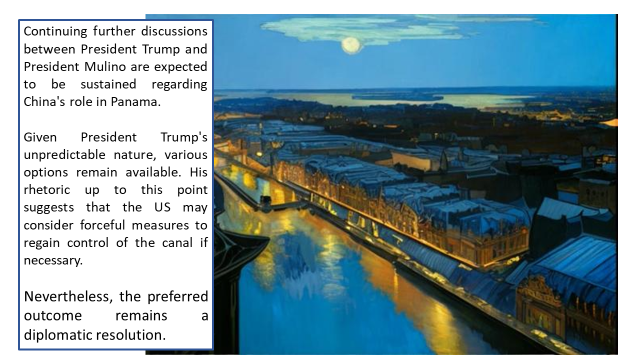
If President Trump’s statements are taken at face value, it appears unlikely that he will agree to terms without at least increased cooperation on security matters pertaining to the canal. This would involve US military collaboration with Panamanian counterparts to ensure neutrality. Potential measures could include operational audits, particularly of port operations, and shared oversight of bridge construction. In return, Panama is expected to seek economic support to offset the loss of a key infrastructure partner, thereby reinforcing the US as Panama’s primary geopolitical ally.
A few weeks is a long time in geopolitics and anything could yet happen. But one thing is evident; US foreign policy is no longer globalist aligned. With President Trump and Secretary Marco Rubio US foreign policy is once again focused on America First.
Join us.
republic.us
noglobalism.com
To Take Action to Save America’s Sovereignty and Your Freedoms
JOIN REPUBLIC- Promotion Code – 10$/mnth
SOURCES
https://thediplomat.com/2019/02/the-real-danger-of-chinas-national-intelligence-law/
https://1997-2001.state.gov/policy_remarks/1999/991022_gutierrez_panama.html
https://www.northamericaoutlookmag.com/company-profiles/56-panama-ports-company
https://www.nytimes.com/2017/06/13/world/asia/taiwan-panama-china-diplomatic-recognition.html
https://www.csis.org/analysis/key-decision-point-coming-panama-canal
https://en.wikipedia.org/wiki/China_Communications_Construction_Company
https://www.csis.org/analysis/key-decision-point-coming-panama-canal
https://panamaadvisoryinternationalgroup.com/blog/panama-canal-bridge-inches-toward-a-restart/
https://dialogo-americas.com/articles/china-to-proceed-with-fourth-bridge-over-panama-canal/
https://www.chinaconstruction.us/project/amador-convention-center/
http://en.sasac.gov.cn/2024/04/18/c_16982.htm
https://www.maritime-executive.com/article/panama-canal-authority-signs-for-a-new-cruise-terminal
https://www.newsweek.com/leader-jose-raul-mulino-hits-back-trump-panama-not-distracted-2019095
https://www.theguardian.com/us-news/2025/feb/06/panama-canal-trump-marco-rubio
https://www.washingtontimes.com/news/2025/feb/2/panama-renew-china-belt-road-initiative-rubio-meee/
https://x.com/sentdefender/status/1887360984500638112